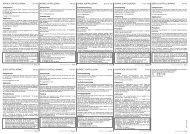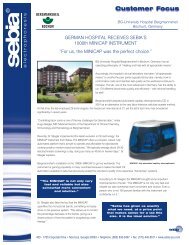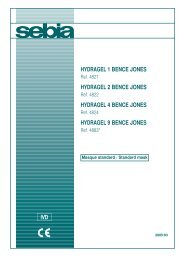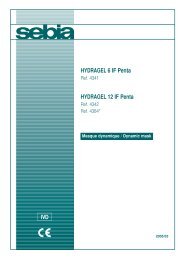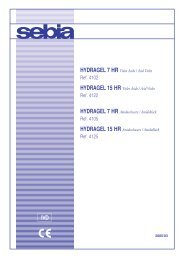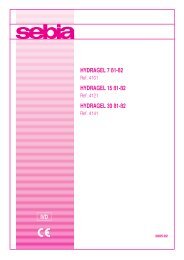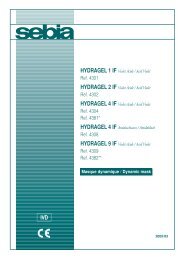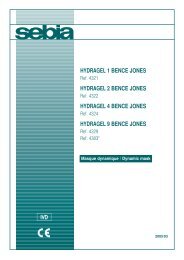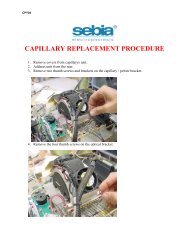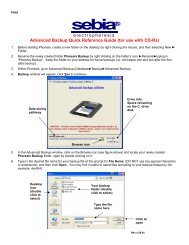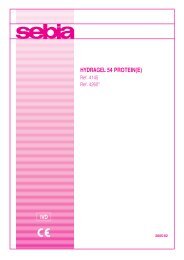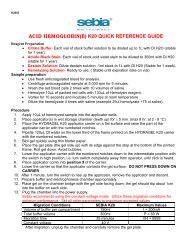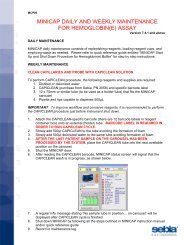HYDRAGEL HEMOGLOBIN(E) K20
HYDRAGEL HEMOGLOBIN(E) K20 - Sebia Electrophoresis
HYDRAGEL HEMOGLOBIN(E) K20 - Sebia Electrophoresis
- No tags were found...
You also want an ePaper? Increase the reach of your titles
YUMPU automatically turns print PDFs into web optimized ePapers that Google loves.
<strong>HYDRAGEL</strong> <strong>HEMOGLOBIN</strong>(E) <strong>K20</strong> - 2005/03<br />
Use<br />
Electrophoresis buffer.<br />
Storage, stability and signs of deterioration<br />
Store stock buffer solution at room temperature or refrigerated. Stock solution is stable for several years, at least until the expiration date indicated on<br />
the kit package or buffer vial labels. Diluted buffer solution is stable for one year at room temperature in a closed bottle.<br />
Discard diluted buffer if it changes its appearance, e.g., becomes cloudy due to microbial contamination.<br />
3. STAINING SOLUTION DILUENT<br />
Preparation<br />
The stock staining solution diluent must be used as described in paragraph " AMIDOBLACK STAIN ".<br />
It contains an acidic solution.<br />
Use<br />
For the preparation of the amidoblack staining solution.<br />
Storage, stability and signs of deterioration<br />
Store the stock staining solution diluent at room temperature or refrigerated. It is stable until the expiration date indicated on the kit package or staining<br />
solution diluent vial labels. DO NOT FREEZE.<br />
Do not add any sodium azide.<br />
4. AMIDOBLACK STAIN<br />
Preparation<br />
The amidoblack concentrated stain is a visquous solution which may gelify. The integrity of the stock staining solution is not altered by the increase in<br />
viscosity or solidification.<br />
In all cases, to obtain a perfect reconstitution of the stain, we advise you to respect the following procedure:<br />
1. Add 15 mL of stain diluent to the concentrated amidoblack vial.<br />
2. Close carefully the vial.<br />
3. Shake very vigorously the vial during approximately 5 seconds.<br />
4. Pour this solution in the container for staining solution processing.<br />
5. Repeat this step twice, three times if necessary.<br />
6. Pour the remaining diluent in the container and complete the volume to 300 mL with distilled or deionized water.<br />
7. Mix contents of stain cubitainer well for 5 to 10 minutes.<br />
The staining solution is ready to use.<br />
After dilution, the working staining solution contains: acid solution pH ≈ 2 ; amidoblack, 0.4 g/dL ; ethylene-glycol, 6.7 % ; additives, nonhazardous at<br />
concentrations used, necessary for optimum performance.<br />
WARNING: Harmful if swallowed.<br />
Use<br />
For staining gels with electrophoretic protein separations.<br />
IMPORTANT : The staining solution is designed to stain only 10 gels. Change the solution after 10 staining steps.<br />
Storage, stability and signs of deterioration<br />
Store both stock and working staining solutions at room temperature or refrigerated in closed containers to prevent evaporation. Stock staining solution<br />
is stable until the expiration date indicated on the kit package or staining vial labels.<br />
Working staining solution is stable for 1 month.<br />
Do not store the working staining solution close to a heat source.<br />
5. DESTAINING SOLUTION<br />
Preparation<br />
Each vial of stock destaining solution to be diluted up to 100 liters with distilled or deionized water. It is convenient to dilute only 1 mL of the stock<br />
solution to 1 liter. After dilution, the working destaining solution contains: citric acid, 0.05 g/dL.<br />
Use<br />
For destaining, that is removal of excess and background stain from the gels.<br />
Storage, stability and signs of deterioration<br />
Store the stock destaining solution at room temperature or refrigerated. It is stable until the expiration date indicated on the kit package or destaining<br />
solution vial labels. Working destaining solution is stable for one week at room temperature in a closed bottle.<br />
Discard working destaining solution if it changes its appearance, e.g., becomes cloudy due to microbial contamination.<br />
Do not add any sodium azide.<br />
To prevent microbial proliferation in the diluted destaining solution to be stored more than one week, add 5 µL/dL of ProClin 300.<br />
Working destaining solution added with ProClin is stable in a closed bottle at room temperature or refrigerated until the expiration date indicated on<br />
the kit package or destaining solution vial labels.<br />
6. HEMOLYZING SOLUTION<br />
Preparation<br />
Hemolyzing Solution is ready to use. It is a buffer with additives, nonhazardous at the concentration used, necessary for optimum performance.<br />
Use<br />
To hemolyze red blood cells.<br />
Storage, stability and signs of deterioration<br />
Store Hemolyzing Solution at room temperature or refrigerated. It is stable until the expiration date indicated on the kit package or Hemolyzing Solution<br />
vial label.<br />
Discard Hemolyzing Solution if it changes its appearance, e.g., becomes cloudy due to microbial contamination.<br />
7. APPLICATORS<br />
Use<br />
Precut, single use applicators for sample application.<br />
- 9 -



